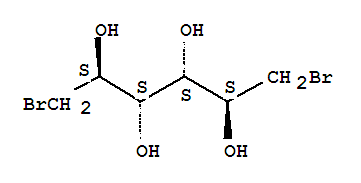D-Mannitol,1,6-dibromo-1,6-dideoxy- cas no:488-41-5
Synonyms: Mannitol,1,6-dibromo-1,6-dideoxy-, D- (8CI); 1,6-Dibromo-1,6-dideoxy-D-mannitol;1,6-Dibromo-1,6-dideoxymannitol; 1,6-Dibromo-D-mannitol; 1,6-Dibromomannitol;1,6-Dideoxy-1,6-dibromo-D-mannitol; D-Dibromomannitol; DBM; Dibromannit;Dibromannitol; Dibromomannitol; Mielobromol; Mitobronitol; Myebrol;Myelobromol; NCI C04762; NSC 94100; NSC 94110; R 54
NameD-Mannitol,1,6-dibromo-1,6-dideoxy-
CAS488-41-5
SynonymsMannitol,1,6-dibromo-1,6-dideoxy-, D- (8CI); 1,6-Dibromo-1,6-dideoxy-D-mannitol;1,6-Dibromo-1,6-dideoxymannitol; 1,6-Dibromo-D-mannitol; 1,6-Dibromomannitol;1,6-Dideoxy-1,6-dibromo-D-mannitol; D-Dibromomannitol; DBM; Dibromannit;Dibromannitol; Dibromomannitol; Mielobromol; Mitobronitol; Myebrol;Myelobromol; NCI C04762; NSC 94100; NSC 94110; R 54
EINECS(EC#)207-676-8
Molecular FormulaC6H12 Br2 O4
Molecular Weight308.00
refractive index1.622
storage temp−20°C
Hazard T: Toxic;
Risk 45-22
Safety
Safty information about 1,6-Dibromomannitol (CAS NO.488-41-5) is:
Moderately toxic by ingestion, intravenous, intraperitoneal, and subcutaneous routes. Questionable carcinogen with experimental carcinogenic and neoplastigenic data. Experimental teratogenic and reproductive effects. Human mutation data reported. When heated to decomposition it emits toxic fumes of Br−.
Hazard Codes:
 T
T
Risk Statements:
R45:May cause cancer.
R22:Harmful if swallowed.
Safety Statements:
S53:Avoid exposure - obtain special instructions before use.
S22:Do not breathe dust.
S36/37/39:Wear suitable protective clothing, gloves and eye/face protection.
S45:In case of accident or if you feel unwell, seek medical advice immediately (show the label whenever possible.)
WGK Germany: 3
RTECS: OP2800000
| Organism |
Test Type |
Route |
Reported Dose (Normalized Dose) |
Effect |
Source |
| mouse |
LD50 |
intraperitoneal |
900mg/kg (900mg/kg) |
BEHAVIORAL: TREMOR
BEHAVIORAL: ATAXIA
SKIN AND APPENDAGES (SKIN): HAIR: OTHER |
Oyo Yakuri. Pharmacometrics. Vol. 6, Pg. 831, 1972. |
| mouse |
LD50 |
intravenous |
2200mg/kg (2200mg/kg) |
|
Iyakuhin Kenkyu. Study of Medical Supplies. Vol. 8, Pg. 680, 1977. |
| mouse |
LD50 |
oral |
1380mg/kg (1380mg/kg) |
BEHAVIORAL: TREMOR
BEHAVIORAL: ATAXIA
SKIN AND APPENDAGES (SKIN): HAIR: OTHER |
Oyo Yakuri. Pharmacometrics. Vol. 6, Pg. 831, 1972. |
| mouse |
LD50 |
subcutaneous |
2200mg/kg (2200mg/kg) |
BEHAVIORAL: TREMOR
BEHAVIORAL: ATAXIA
SKIN AND APPENDAGES (SKIN): HAIR: OTHER |
Oyo Yakuri. Pharmacometrics. Vol. 6, Pg. 831, 1972. |
| rabbit |
LD50 |
oral |
1080mg/kg (1080mg/kg) |
|
Oyo Yakuri. Pharmacometrics. Vol. 6, Pg. 831, 1972. |
| rat |
LD50 |
intraperitoneal |
900mg/kg (900mg/kg) |
BLOOD: NORMOCYTIC ANEMIA
BLOOD: THROMBOCYTOPENIA |
European Journal of Cancer. Vol. 4, Pg. 617, 1968. |
| rat |
LD50 |
intravenous |
1370mg/kg (1370mg/kg) |
|
Iyakuhin Kenkyu. Study of Medical Supplies. Vol. 8, Pg. 680, 1977. |
| rat |
LD50 |
oral |
1500mg/kg (1500mg/kg) |
GASTROINTESTINAL: "HYPERMOTILITY, DIARRHEA"
GASTROINTESTINAL: OTHER CHANGES
BLOOD: NORMOCYTIC ANEMIA |
Oyo Yakuri. Pharmacometrics. Vol. 6, Pg. 831, 1972. |
| rat |
LD50 |
subcutaneous |
1240mg/kg (1240mg/kg) |
GASTROINTESTINAL: "HYPERMOTILITY, DIARRHEA"
GASTROINTESTINAL: OTHER CHANGES
BLOOD: NORMOCYTIC ANEMIA |
Oyo Yakuri. Pharmacometrics. Vol. 6, Pg. 831, 1972. |


 T
T